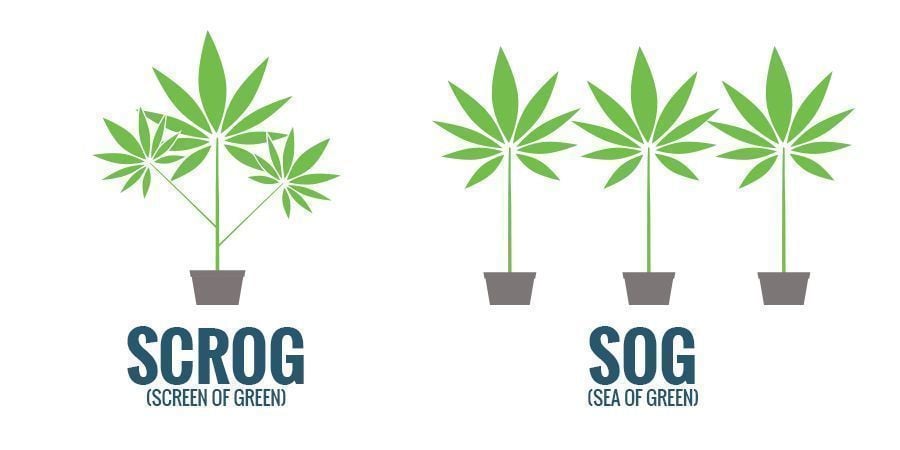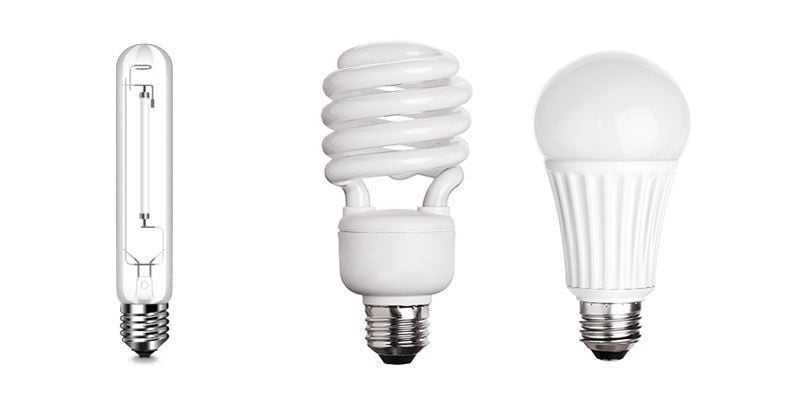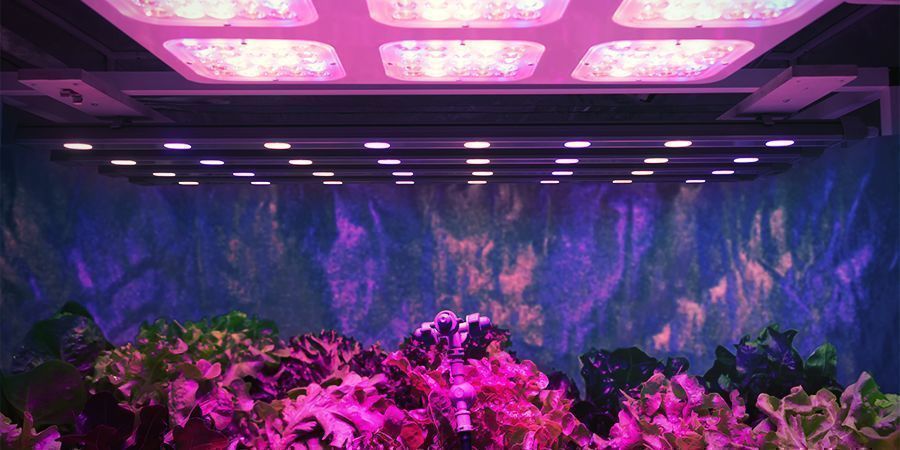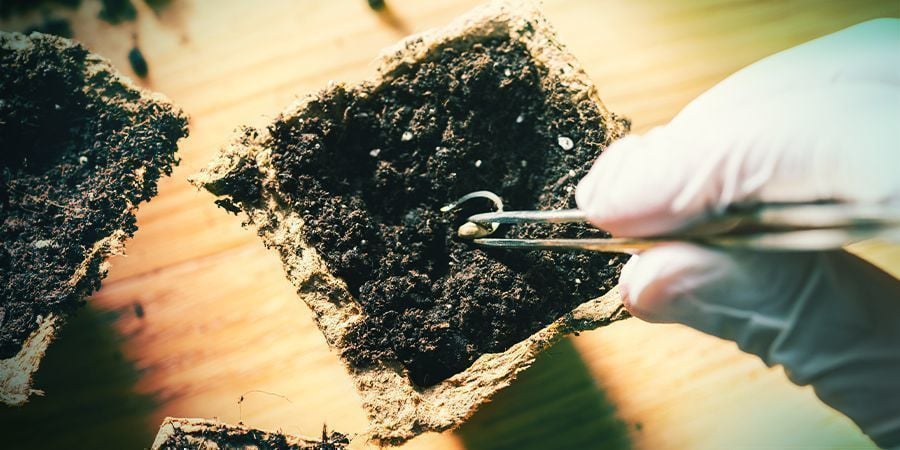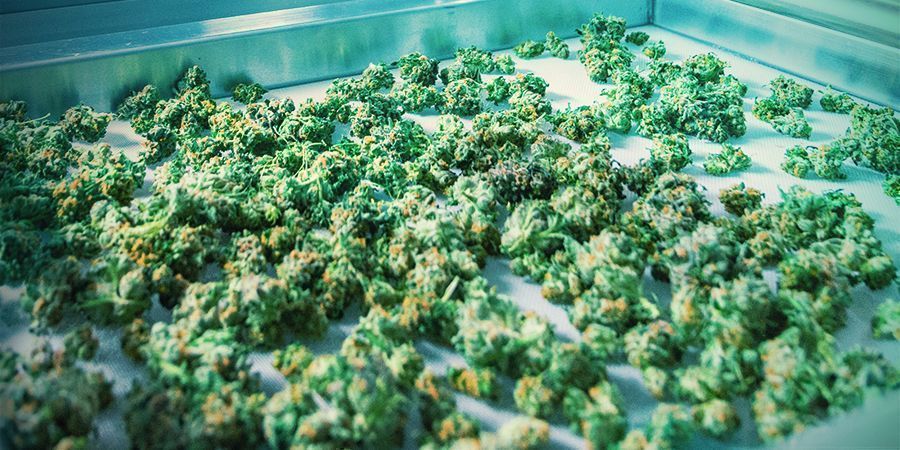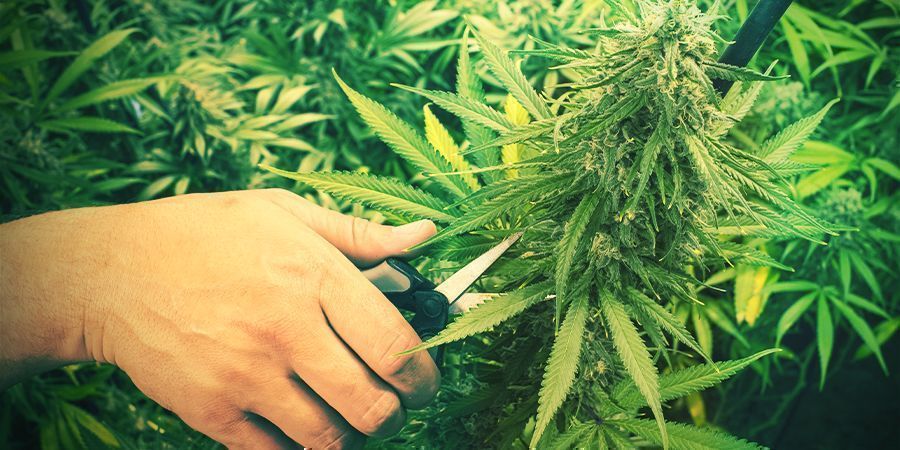How Many Cannabis Plants Should You Grow Per Square Metre?
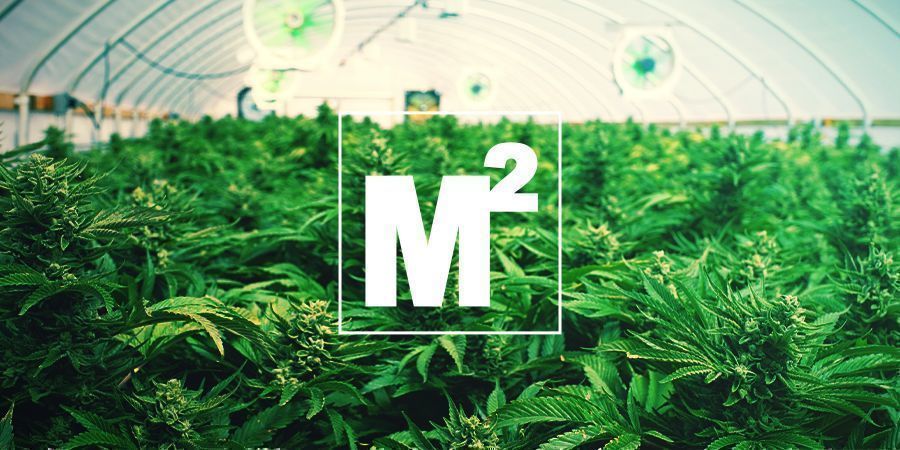
When growing cannabis, the aim, of course, is to get as many fat buds in the jar as possible at harvest time. Growing too many or too few plants can affect the yield and take an undesirable amount of time. Growing several species that have different growth characteristics can disadvantage plants with a smaller stature. It can be a bit of a balancing act, but one that can be easily mastered.
So, how many plants can you grow in a square metre of grow space? This question has a layered answer, which depends on a number of factors.
The easy answer is to grow 1–8 plants per square metre. This allows for a number of necessary plant-friendly conditions:
- A decent pot size for roots and therefore whole plant development
- Generous light distribution over the whole grow
- Beneficial airflow over grow medium and all plant surfaces
- Ease of access for regular maintenance
GROW SPACE SIZE
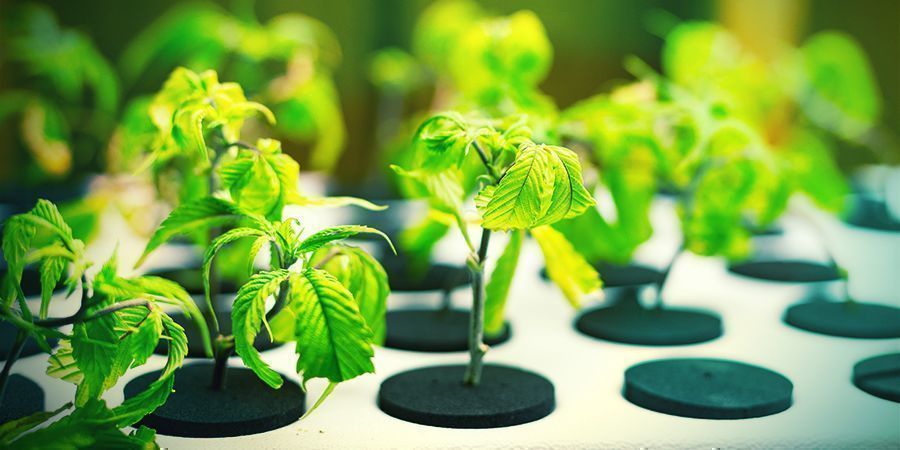
The size of your grow space determines the amount of containers that will fit in. Depending on the growing style, this can mean a large number of smaller containers—as in a SOG setup—or a few large containers for bigger plants in a ScrOG or a DWC grow, which take up space by nature.
GROWING STYLE
Depending on how plants are treated, they can place different demands on the space:
- Plants left to grow naturally will take up both height and volume
- Plants that are trained will take up less height, but more area
- SOG will use less area per plant, with lower height requirements
- ScrOG will need more area per plant, with lower height requirements
- Topping, fimming, and LST will decrease height while increasing volume
SPECIES SELECTION
Having a choice of cannabis strains from which to select has its advantages. You can pick what suits your mood or activities, and swapping things around avoids building up a tolerance. However, in the grow room, having different species growing together can cause some difficulty.
Having taller species beside shorter species can mean the shorter species do not get enough light. The light needs to be raised to accommodate the taller plants, depriving the smaller plants of bud-building lumens. In these situations, training techniques are a great advantage.
TYPES OF LIGHTS AND LIGHT STRENTGH
Light strength goes a long way in determining how many plants you can fit in a grow space. The more powerful the light output, the greater the area covered, and the more plants that can be grown. Figuring out your light footprint will help you determine the actual effective area you have available for healthy plant growth.
HID Lights—HPS & MH
The effective light footprint for the different wattages of high intensity discharge lamps are as follows:
- 150W: 60 × 60cm
- 250W: up to 80 × 80cm
- 400W: up to 1 × 1m
- 600W: up to 1.2 × 1.2m
- 1000W: up to 1.5 × 1.5m
CFLs & OTHER FLUORESCENT BULBS
These types of light sources only have a minimal effective footprint and only illuminate the area immediately under the bulbs. The distance to the canopy should be as little as 5–10cm while the whole plant needs to be within 30cm of the bulb or it will be outside of the effective range.
LEDs
The light footprint of LEDs varies with output and bulb types (white, blue, UV, infrared). Refer to the manufacturer's recommendations for maximum efficiency.
LIGHT STRENGTH PER PLANT
Your plants still require a minimum amount of wattage or lumens per plant to grow. The desired amount of wattage is at least 75 watts per plant for HID-style lamps and 150 watts per plant for CFL and fluorescent bulbs.
Any less than these minimums will cause slow growth and unsatisfactory bud development. Make sure you have enough light for your plants to grow properly!
The easiest calculation for HID lighting is to divide the wattage of your light by 75 (with fractions rounded up). For example:
- 150W HID ÷ 75W = 2 plants
- 250W HID ÷ 75W = 3.3 or 4 plants
- 400W HID ÷ 75W = 5.3 or 6 plants
- 600W HID ÷ 75W = 8 plants
- 1000W HID ÷ 75W = 13.3 or 14 plants
When using CFLs, divide by 150W. If you were using 400W of CFLs for example:
-
400W CFL ÷ 150W = 2.6 or 3 plants
Remember, these are the minimum requirements for healthy plant growth. More is always desirable, but there is cost, space, and power usage to consider for each individual. Safety and plant health should be considered as well. A 600W light in a cupboard presents overheating issues, which is bad for plant health—and you could burn your house down.
POT SIZE & TYPE
After considering available light for effective and efficient growing, selecting the pot size is next on the list. The pot size determines the size of the root zone, which in turn determines the size of the plants. Small plants for SOG-type grows only need small pots, while growing fewer larger plants means larger pots.
As a general guide for the size of hand-watered plants:
| Height (cm) |
Pot size (liters) |
Pot diameter (cm) |
| 30 | 7–11 | 25–28 |
| 60 | 11–15 | 28–33 |
| 90 | 15–25 | 33–38.5 |
| 120 | 25–40 | 38.5–50 |
| 150 | 40+ | 50+ |
Pots that are too small can stunt plants and also lead to conditions that imitate nutrient deficiencies.
Another thing to consider is that the plant canopy will grow larger than the pot. Remember to leave enough room around each pot for plants to expand as they grow. Crowding of plants can affect valuable air circulation and cause ideal conditions for unwanted pathogens.
Pots should be the appropriate size for each stage of growth. Transplant the seedlings as they outgrow their germination medium into an intermediate pot, and then once again into the final large pot. This way, overwatering (with its pitfalls of root rot and lack of vigour) can be avoided.
Germinating directly into large pots is okay, but attention needs to be paid to watering techniques. It is very easy to overwater young plants in big pots. When plants are young with little root development, they are still too young to transpire large amounts of water.
Be sure not to thoroughly water all of the growing medium. Water gently in a small circle around the young plant every 3–4 days. As the plant develops, water in a ring that extends to the limit of the canopy. Once the canopy reaches the edge of the pots, a regular watering routine can begin.
DESIRED HARVEST & WAYS TO INCREASE YIELD
As a rule of thumb, any specific grow room volume will produce similar yields, whether it is many plants grown quickly, or a few plants grown over a longer period of time. Factors like strain, skill, and grow light strength play their part.
But 8 small plants grown quickly will produce about the same yield as 1 large plant grown over a longer period. Light can reach every surface of smaller or well-trained plants, while larger plants will have underdeveloped buds the further from the light they are, but with more branches per plant.
There are a number of methods used to make the most of space and light penetration. Vegetation and maintenance times vary with each method, but they can each maximise yield in their own particular way.
1. SOG (SEA OF GREEN)
The sea of green technique is all about curtailing vegetation time as much as possible while maximising yield and grow space efficiency. A large number of small plants is the goal, rather than fewer larger plants.
When growing from clones, as little as ten days vegetation are allowed after the clones have rooted. With standard photoperiod and feminized strains, only 3–4 weeks vegetation is required. The ideal scenario is to grow many singular large colas with minimal lateral and understory growth.
Pot sizes are kept small—with 11 litres being the maximum—where tall square pots are preferred over larger yet inefficient and shallow round pots. This allows for a maximum number of plants—typically 8–16—per square metre.
Plants are trimmed to control shading of their neighbours, and shaded lower lateral branches that don’t receive much light are removed. This encourages all the plant's energy to be directed to the larger flower clusters in full light.
With such a short turnaround time, SOG is ideal for smaller spaces like cupboards. With a mother plant and a separate vegetation space, the next lot of plants can be put into flowering the moment the present batch is harvested.
2. SCROG (SCREEN OF GREEN)
Loved by growers but hated by autocorrect, the ScrOG or screen of green technique is another growing method that maximises yield in the grow space. Ideal where space is an issue, ScrOG limits overall height by training a whole plant out into a flat sheet of green.
It helps to be familiar with topping and LST methods early in vegetation and lollipopping or mainlining during flowering. When plants are vegetating, they are topped, and ensuing branches are trained laterally rather than being left to “bush out”. This method uses fewer plants with a longer vegetation time than the SOG technique.
After being topped, and once the plants have developed a number of main stems that are trained to grow laterally, a flat screen is put in place about 30cm from the top of the pot. Fencing wire with large apertures or plastic netting can be used. These are situated on a frame that fills the complete grow space.
As plants continue to grow, branches that reach for the light are tucked under the netting. Over the rest of the vegetation phase, the plants are encouraged to grow entirely flat. Once the screen and grow space are 70% full, the changeover to flowering is made.
While the flowering stretch is happening, new branches and extra length are also tucked under the screen. As flowers form, there is no apically dominant cola. Instead, a miniature field of homogeneously-sized colas develop. Leaves and popcorn buds that form underneath the thick canopy are trimmed away so all the plant’s energy is focussed on the buds in the light. This also leaves a generous plenum or manifold for vital air circulation.
Use one or two plants that would normally be tall like a Haze, or four plants that would normally be shorter like a OG Double Bubble, per square metre.
3. LST (LOW STRESS TRAINING)
Another method of maximising light penetration for optimal plant development and flower size per square metre is low-stress training. Unlike high-stress methods like topping and pruning, LST manipulates the whole plant to grow more efficiently.
LST encourages more intense light penetration to the plant's lower lateral branches by preventing shading. Usually, slower-developing branches respond by growing more and developing more bud sites. At the same time, as the main cola is bent lower, a more homogeneous plant is grown.
Simple equipment is all that’s needed for LST. Soft gardening wire, string, or a packet of plant ties are each as effective as the other. It helps to drill a series of holes into the pot edges to provide an anchoring point.
Beginning as of when plants are young, bend the top of the plant horizontally. As branches fight for apical dominance and reach for the light, tie them down as well. Continue until the grow space is filled to your desire.
The vegetation time is shorter as the plant has no need to recover from the stress of topping or pruning. Thought needs to be given to the extra volume a trained plant will achieve. With less plants per square metre than SOG, but more than ScrOG, LST is the patience vs space compromise.
One or two big, sativa-style plants like a Super Silver Haze, or four to six indica-style plants like Gorilla Glue should fit in the space of a m². Just make sure they all get good light and air circulation.
4. PRUNING
Pruning is an umbrella term that covers a number of ways to manipulate the growth of cannabis. These include topping, fimming, mainlining, lollipopping, and defoliation and schwazzing.
-
Topping
Topping involves pinching or cutting off the emerging plant tips, which makes the potential lateral branches at that point grow into two new main stems. Top once for two main stems. Top twice for four main stems. Top thrice, eight main stems, etc. Most indoor growers won’t go past three toppings, as by this time vegetation time is slipping away while plants recover. Eight main branches will grow into a bushy plant, taking up serious volume. Topping is also called tipping.
-
Fimming
Fimming is an accidental discovery that had beneficial effects on the efficient growth of cannabis plants. Rather than completely removing the emerging tip to make two new stems, about 75% of the emerging rabbit ears are trimmed or pinched away. This gives rise to 4+ new shoots, while lateral branches have time to catch up, which in turn produces larger main buds on the ends of these branches.
-
Mainlining
Mainlining and lollipopping are two similar techniques that only promote the growth of large buds at the ends of branches. With mainlining, a plant that has been topped multiple times (see above) then has all superfluous and new growth removed, leaving only the main cola and immediate lateral buds. This forces all the plant's energy to focus on the remaining colas.
-
Lollipopping
Lollipopping is similar to mainlining, only it can be used with any style of growing. All main branches, including the main cola in untrained plants, are trimmed of all growth, except the main bud and immediate lateral flowers. As with mainlining, this forces the plant to direct all its energy into the large buds.
-
Defoliation
Schwazzing or defoliation is a counterintuitive pruning technique that takes some practice, but produces good results. Usually once during vegetation, then in the first three weeks of flowering, up to 50% of the fan leaves are removed. During veg, this promotes light penetration and air circulation deeper into the grow space, encouraging exposed branches to grow larger. During flowering, this promotes the development of more calyxes to do the work the removed leaves should have been doing.
At the end of the day, each of these techniques has been shown to increase yields. If you are a keen cannabis grower, try each of them, keep a record, and charge ahead with what works for you.
TIMELINE
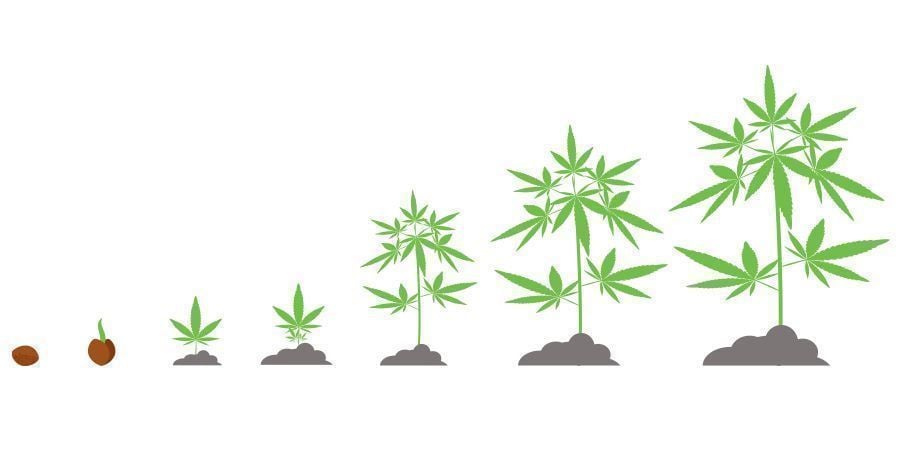
To fill a grow space efficiently, a single plant grown naturally may need 8 weeks of vegetation prior to the flowering cycle. Switch to flowering any earlier and the space will not be filled, and yields will be less than what the volume could effectively produce.
If there are two plants, then the vegetation time is halved to achieve the same efficient use of space and a similar yield. Likewise, 4 plants can be vegged for less time, and 8 plants even less. Less vegetation time means less electricity used, but more maintenance.
Ultimately, the more plants grown reduces the overall vegetation time and efficiently fills the space sooner. Flipping to flowering happens earlier, so the time to harvest is shorter, although more plants means more time spent tending to them.
BUDS, BUDS EVERYWHERE
It really isn’t as arcane as it seems. You just need to remember that these stinky bud-producing things are plants. They can be fickle and idiosyncratic. Have an experiment and find what is right for you. Your grow space will have its own particular micro-environment compared to what was successful halfway round the world. Moon phase, the occultation of Jupiter, and time of year still reach into the artificial grow space and work their magic. Once you get it all dialled in, you will always win a game of "my nugs are bigger than yours".













 United States
United States

